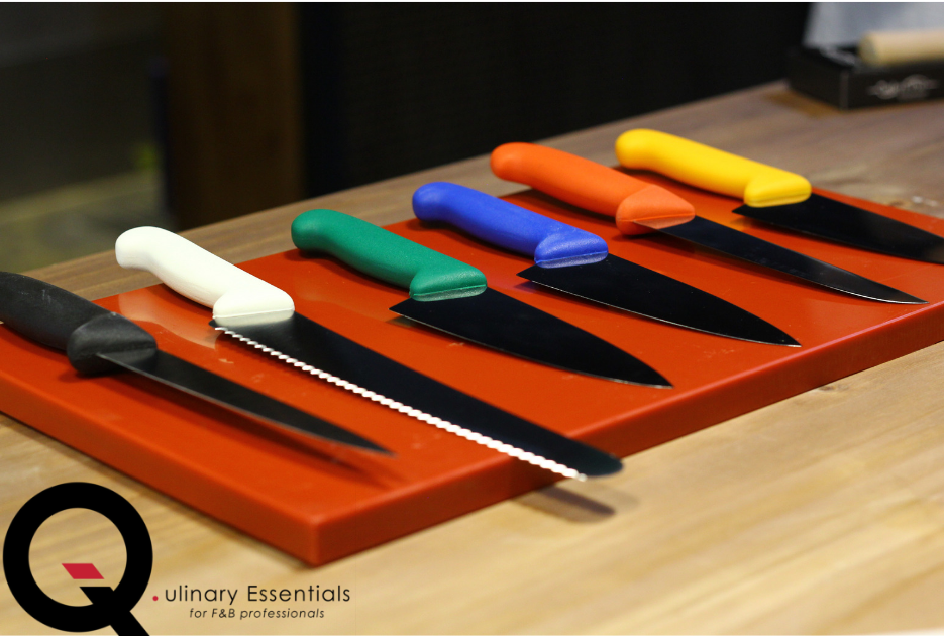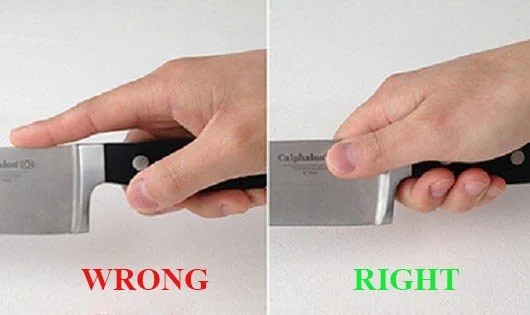How to use knife like a Chef
Holding and using a professional chef's knife can be intimidating. These knives are incredibly sharp and can cause serious injury if not handled properly. However, with the right techniques and regular practice, you can use a chef's knife like a pro. Let’s find out with Q.uriosity Culinary Academy.
Choose the Right Chef Knife
Knowing clearly how to use the equipment in the kitchen is one of Chef's tips for success. Take the time to familiarize yourself with each object, its functions, and how to properly use and maintain it. This will not only help you work more efficiently but also keep you safe.
The first step in using a chef knife effectively is selecting the right one. Chef's knives are versatile tools that can be used for various tasks, such as cutting and slicing vegetables or different types of meat. They typically have a blade length of 15-35cm and a width of about 4cm. While the long edge can be challenging for non-professionals to use, it's highly efficient for chefs who need to cut and slice quickly and beautifully. Additionally, chef knives are usually of moderate weight, which enables chefs to hold them firmly without feeling fatigued after extended use.
There are different types of chef knives, including:
• Fillet Knife: This type of knife features a long, thin blade design that's often used to separate meat fibers from bones or remove fish skin and bones. It's also effective in slicing raw fish into thin slices.
• Cleaver: Cleavers have larger, thicker, and heavier blades than other kitchen knives. They're typically used for chopping bones, mincing meat, and dividing large ribs. As they're quite large, chefs must hold them firmly and handle them carefully.
• Paring Knife: This type of knife often has a small, sharp, and pointed blade. Chefs favor it for cutting and carving vegetables.
2. Hold the Chef Knife Correctly
After selecting the right knife, it's crucial to hold it correctly. Hold the knife firmly, grip the blade with your index finger and thumb, and hold the handle tightly with your other fingers. Use your other hand to hold the food with the Claw Grip technique, which helps keep the food in the correct position. This means you'll use your thumb and index finger to maintain the food while your other fingers hold it tightly to prevent it from slipping.
3. Willing To Learn And Improve
Cutting Techniques
Now it's time to learn how to cut with it. Basic cutting techniques include:
• Chop: The most straightforward cutting technique that involves cutting food into small pieces by moving the knife up and down. You need to use your thumb and index finger to hold the knife, with the other hand placed on the blade to adjust its direction and keep the tip of the knife pointing down.
• Slice: This cutting technique cuts food into thinner slices. Place the knife blade near the food and push it forward. This technique is often used for preparing vegetables for stir-fry or salad.
• Julienne: This cutting technique creates long, thin strips of food. Place the food perpendicular to the knife and cut. This method is typically used for vegetables such as carrots, potatoes, bell peppers, cucumbers, turnips, and more.
• Mince: This cutting technique is used to cut food into smaller pieces. Place the knife blade on the food and move it up and down quickly and smoothly.
4. Kitchen Knife Maintenance
After finishing cutting, remember to clean and store your kitchen knife properly. Wash the blade with water and mild detergent, then dry and store it in a knife block, a magnetic strip, or a specialized knife drawer, arranging it properly to avoid scratches or damage. Don't soak the knife in water for too long or wash it in a dishwasher. Avoid exposing the knife to high temperatures by heating it on fire or leaving it in direct sunlight for a long time.
5. Ensure the Knife is Always Sharp Regularly
To ensure your knife stays sharp, it's important to sharpen the blade regularly. However, be careful not to over-sharpen or sharpen the knife improperly, as this can damage the knife's steel and reduce its lifespan and functionality.
If you're interested in mastering cutting techniques and improving your culinary skills, consider enrolling in the Q.uriosity Culinary Academy. Our courses cover everything from basic to advanced cutting techniques. Throughout the course, you'll also have access to modern, professional kitchen knife sets to practice with. Moreover, If you're looking to invest in a high-quality kitchen knife set for home use, check out the QE Kitchen Store. We offer a wide range of modern kitchen utensils at affordable prices, including professional knife sets that will help take your cooking to the next level.




